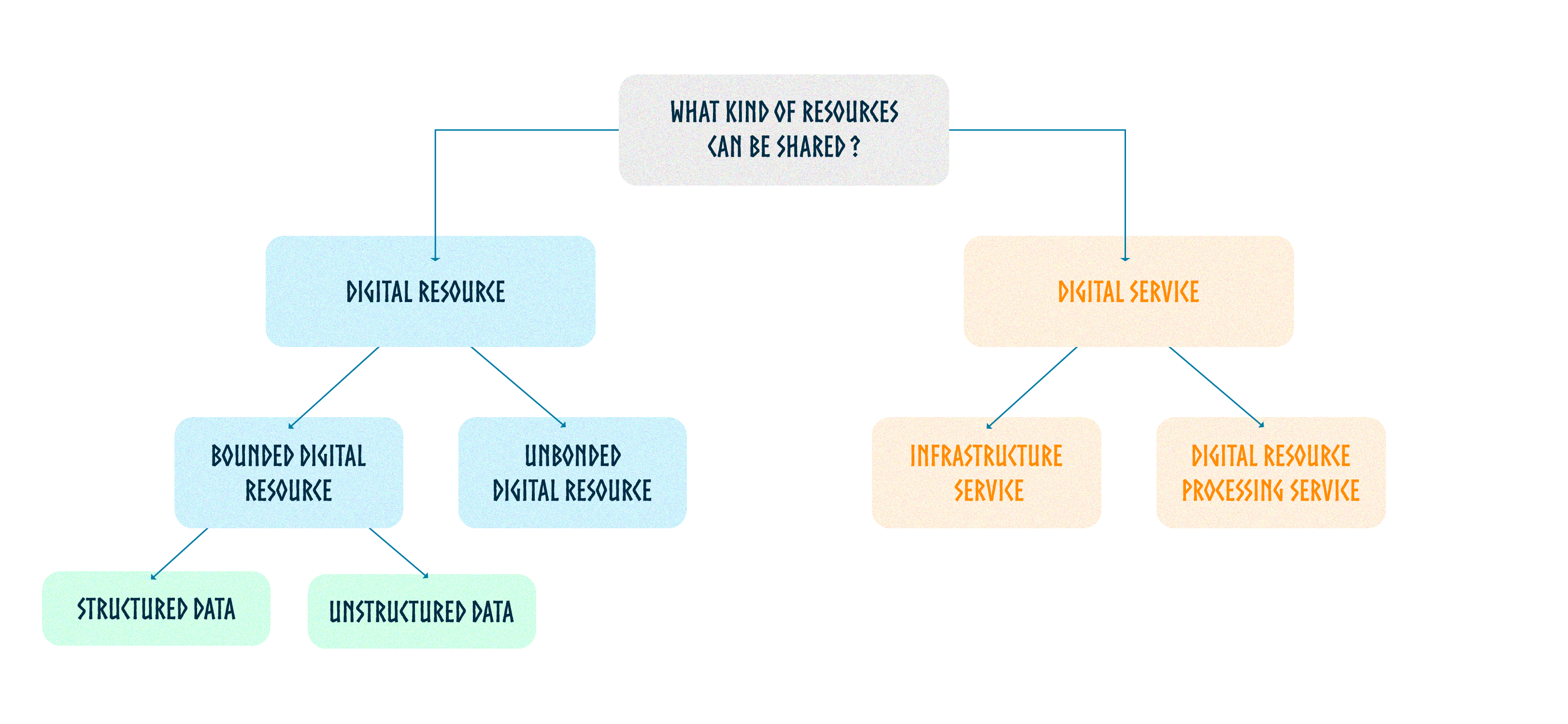Resources: what can be shared
Digital resources, the building blocks for extracting insights and generating new knowledge, come in various forms and formats. There are two types of resources: Digital Resources and Digital Services.
Digital Resources
Digital Resources are the raw material from which insights and new knowledge are extracted. They include data in various forms (spreadsheets, text, videos) and formats (.xml, .json, .txt, .mp4). These Digital Resources can be categorized into two subtypes:
-
Bounded digital resources have a limited size and defined boundaries regarding time. They are often accessed and analyzed as complete entities, commonly referred to as datasets. These datasets are further classified into structured data, such as databases or spreadsheets, and unstructured data, including text documents, images, videos, and more.
-
Unbounded digital resources have no boundaries defined in terms of time. This data may have originated in the past, persisted into the present, and is expected to continue arriving in the future. This absence of predefined boundaries implies that unbounded resources do not have a set size and are characterized by their continuous and potentially infinite nature. Examples of unbounded resources include streaming and real-time data: sensor data from IoT devices, social media feeds, or stock market tickers.

Digital Service
To extract new knowledge, raw materials require processing, which is where Digital Services come into play. From this standpoint, Digital Services function as the structural and functional units in the knowledge creation process. They provide the essential service to transform digital resources, facilitating the generation of new knowledge. Digital Services encompass different kinds of service:
Infrastructure Services
Foundational support is provided for efficient resource sharing, establishing the necessary groundwork for transformative capabilities.
Some examples of Infrastructure Services:
- Infrastructure Storage services
- Infrastructure Compute services
- Identity Provider services
- Orchestration Service
Digital Resource Processing Services
Managing intricate processes involved in transforming digital resources, these services play a crucial role in enabling the generation of fresh knowledge. Any algorithms and models can be considered as dedicated solutions to unique needs and objectives of the tasks at hand, from simple logical rules to sophisticated AI-driven algorithms, machine learning models, data processing scripts, image recognition models, predictive analytics, natural language processing (NLP) models etc…

Verifiable Claims
In the Axone protocol, resources are uniquely identified by Decentralized Identifiers (DIDs), allowing for decentralized and verifiable identity management. Verifiable Credentials (VCs) provide detailed and secure information about each resource, enhancing reliability and transparency both off-chain and on-chain.
Example: A Data provider shares a dataset. In the Axone Protocol, this dataset is uniquely identified by the DID d0c63b88-44f8-4518-b62d-e141dd8fb624. Verifiable claims linked to this dataset can include:
Title: MyDataset
Format: csv
Temporal Coverage: 2022
Geographical Coverage: Europe
Served by: (DID of the server where the dataset is stored off-chain)
This approach results in a more reliable and robust system, where the data about resources (also called metadata), backed by the claims from Verifiable Credentials, can be shared and used confidently.
Some VCs are stored off-chain, but critical data is introduced to the blockchain as Verifiable Presentations (VPs). VPs, often a selected subset of VCs with a verifiable chain, serve as the medium for conveying knowledge to the blockchain and are a resource for on-chain governance decisions. They provide a reliable basis for the formulation and execution of governance rules, ensuring that decisions are made based on verified and accurate information.
Ontology: how it's represented, semantic description
The Need for Interoperability
One of the fundamental prerequisites for effective sharing of digital resources is interoperability. Beyond technical considerations, a crucial precondition for resource interoperability is that they speak the same language.
Given the vast diversity of digital resources, each with its own specificities and consent rules, the protocol must express the context as clearly as possible. This clarity is paramount to facilitate seamless communication and understanding among various entities participating in the data-sharing ecosystem.
In the intricate landscape of digital resource sharing, the demand for interoperability underscores the significance of establishing a common ground, a shared language that transcends the unique features of each resource.
Ontological Foundation
At its core, ontology refers to the formal representation of knowledge and the relationships between different entities. In the context of Axone, ontology serves as the backbone, providing a structured framework for understanding the semantics associated with digital resources.
Semantic Enrichment
The representation of ontology in the Axone protocol goes beyond mere categorization. It involves a semantic enrichment process, where resources are classified, and their inherent meaning is also captured. This semantic description enhances the interpretability of digital assets, ensuring a more nuanced comprehension among stakeholders.
Interplay with Verifiable Claims
Ontology and Verifiable Claims synergize within the protocol, creating a powerful combination for resource management. While VCs offer detailed information about the characteristics of a resource, ontology delves deeper, elucidating the relationships, dependencies, and context that define the resource's significance.
Standardization Efforts
The Axone protocol encourages adherence to established ontological standards to foster interoperability and consistency. The protocol ensures a harmonized representation of knowledge across diverse resources by aligning with widely accepted frameworks, such as RDF (Resource Description Framework) or OWL (Web Ontology Language).
Practical Application
In practical terms, the semantic description facilitated by ontology within the Axone protocol extends to various domains. For instance, in the AI sector, ontology can illuminate the intricate relationships between different types of AI algorithms, datasets, and model architectures. This semantic richness provides a comprehensive understanding of the AI landscape, enabling users to navigate and leverage diverse AI resources with greater insight and efficiency.
Ontology forms a cornerstone in the Axone protocol, elevating the representation and semantic description of digital resources. Its integration with metadata and commitment to standardization positions Axone as a forward-looking protocol in the dynamic landscape of data sharing among professionals.
Sum Up
This illustration provides an overview of the classification of digital resources and services within the protocol.
